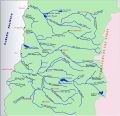| Rapel Lake | |
|---|---|
 | |
| Coordinates | 34°08′S71°30′W / 34.133°S 71.500°W |
| Type | reservoir |
| Primary inflows | Cachapoal River Tinguiririca River |
| Primary outflows | Rapel River |
| Basin countries | Chile |
| Surface area | 80 km2 (31 sq mi) |
| Surface elevation | 110 m (360 ft) |
Rapel Lake (Spanish: Lago Rapel or Embalse Rapel) is an artificial lake created by a dam on the Rapel River. It is located in the Libertador General Bernardo O'Higgins Region, Central Chile.
The reservoir was created with the aim of feeding the Rapel Hydroelectric Plant.

